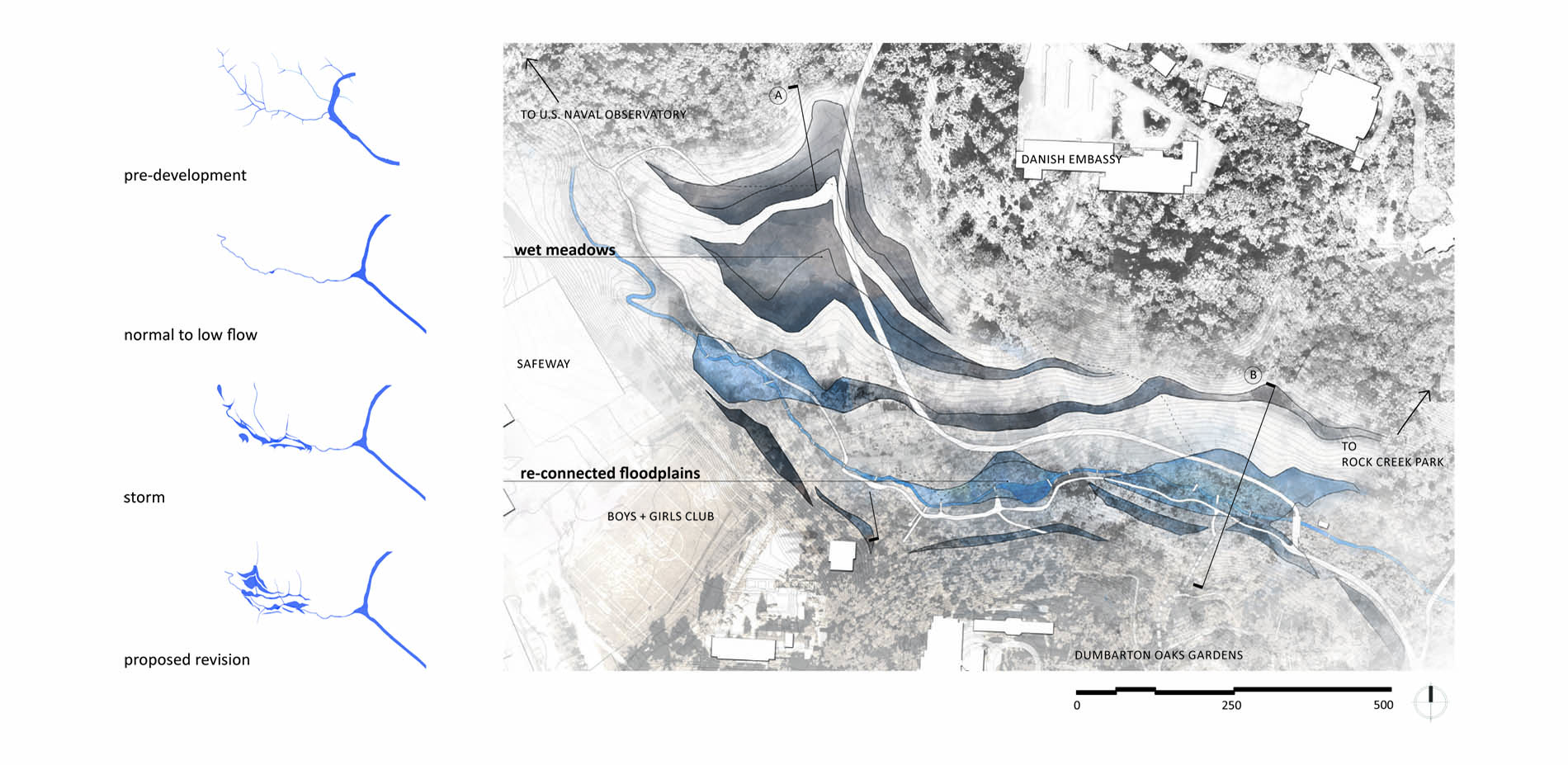
DECONSTRUCTING HYDROLOGIES: REVIVING THE MEMORY OF WATER IN DUMBARTON OAKS PARK. The valley’s historical performance informs a stormwater mitigation design to address ecological imbalance in the Breatrix Farrand-design landscape.
Photo Credit: Elizabeth Anderson, Student ASLA; Historical photos: Dumbarton Oaks Rare Book Collection
Media: Please submit high-resolution image requests to images@asla.org.
The park’s location along the Atlantic Seaboard Fall Line signifies a highly erosive landscape.
Photo Credit: Elizabeth Anderson, Student ASLA; Historical photos: Dumbarton Oaks Rare Book Collection
Media: Please submit high-resolution image requests to images@asla.org.
The park's location in a topographical bowl means that it has always received stormwater from its surrounding watershed.
Photo Credit: Elizabeth Anderson, Student ASLA; Historical photos: Dumbarton Oaks Rare Book Collection
Media: Please submit high-resolution image requests to images@asla.org.
Stream with Farrand-era dams, 1931 and 2013. Stormwater volumes and combined sewer overflows have increased significantly since the Farrand era, due to an increasingly urbanized context. Historical photo: Dumbarton Oaks Rare Book Collection.
Photo Credit: Elizabeth Anderson, Student ASLA; Historical photos: Dumbarton Oaks Rare Book Collection
Media: Please submit high-resolution image requests to images@asla.org.
LAND USE + VEGETATION COVER. Visual appraisals of the valley have been influenced by—and in turn, have influenced—land use and stewardship practices.
Photo Credit: Elizabeth Anderson, Student ASLA; Historical photos: Dumbarton Oaks Rare Book Collection
Media: Please submit high-resolution image requests to images@asla.org.
A strictly visual assessment of the park has been entrenched for decades: In the 1960s the National Park Service described it as a ‘wilderness” (due to declining maintenance) and managed it as a natural instead of a cultural landscape.
Photo Credit: Elizabeth Anderson, Student ASLA; Historical photos: Dumbarton Oaks Rare Book Collection
Media: Please submit high-resolution image requests to images@asla.org.
Farrand’s 18 small check dams were not sized to accommodate the quantity of today’s stormwater runoff, and their capacity is further reduced by erosion and sedimentation. The valley’s sewershed, meanwhile, possesses abundant infiltration potential.
Photo Credit: Elizabeth Anderson, Student ASLA; Historical photos: Dumbarton Oaks Rare Book Collection
Media: Please submit high-resolution image requests to images@asla.org.
INSCRIBING HYDROLOGIES: STORMWATER AS A SPACE-MAKING DEVICE. Stormwater is viewed as a contributing resource. The valley’s topographical and hydrological patterns are vigorously employed to absorb and clean runoff, restoring the landscape’s historical performance, and by extension, Farrand’s original aesthetic goals.
Photo Credit: Elizabeth Anderson, Student ASLA; Historical photos: Dumbarton Oaks Rare Book Collection
Media: Please submit high-resolution image requests to images@asla.org.
Wet meadows: landform is engaged to incrementally trap sediment and slow water, reducing erosion and preserving the open sward-like character of Farrand’s design. Historical photo (1929): Dumbarton Oaks Rare Book Collection.
Photo Credit: Elizabeth Anderson, Student ASLA; Historical photos: Dumbarton Oaks Rare Book Collection
Media: Please submit high-resolution image requests to images@asla.org.
Scooped-out meadows more actively catch and slow water, trap sediment, and clean runoff as it moves downhill. Wetland conditions created by stormwater discourage the growth of invasive species and promote Farrand’s original spatial organization of the meadows.
Photo Credit: Elizabeth Anderson, Student ASLA; Historical photos: Dumbarton Oaks Rare Book Collection
Media: Please submit high-resolution image requests to images@asla.org.
The accumulation of water and sediment eventually alters the landform, ensuring the constancy of change and embedding the need for future stewardship and responsiveness. Visitors understand the valley’s dynamic ecological performance as a critical aspect of the cultural landscape.
Photo Credit: Elizabeth Anderson, Student ASLA; Historical photos: Dumbarton Oaks Rare Book Collection
Media: Please submit high-resolution image requests to images@asla.org.
Farrand’s siting of pools corresponded to historic floodplains, where sub-tributaries originally met the stream. Map: 1861, Library of Congress. Above right: one of the Farrand’s pools, 1931. Below right: pool receiving stormwater today. Historical photo: Dumbarton Oaks Rare Book Collection.
Photo Credit: Elizabeth Anderson, Student ASLA; Historical photos: Dumbarton Oaks Rare Book Collection
Media: Please submit high-resolution image requests to images@asla.org.
Re-connected floodplains: overflow channels reconnect floodplains to relieve pressure on Farrand-era dams in high-flow conditions. Coarse woody debris and engineered log jams deflect stream flow, stabilizing and rejuvenating stream banks.
Photo Credit: Elizabeth Anderson, Student ASLA; Historical photos: Dumbarton Oaks Rare Book Collection
Media: Please submit high-resolution image requests to images@asla.org.
Revegetation along the stream and historic sub-tributaries support Farrand’s historic spatial competition while slowing runoff and restoring rare floodplain habitat.
Photo Credit: Elizabeth Anderson, Student ASLA; Historical photos: Dumbarton Oaks Rare Book Collection
Media: Please submit high-resolution image requests to images@asla.org.
Design for landscape preservation performance could shift Dumbarton Oaks Park from a landscape in conflict with its surrounding systems to a living landscape that remains responsive to its changing cultural, social, and ecological contexts.
Photo Credit: Elizabeth Anderson, Student ASLA; Historical photos: Dumbarton Oaks Rare Book Collection
Media: Please submit high-resolution image requests to images@asla.org.


















